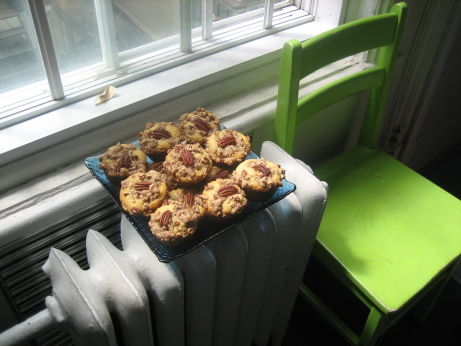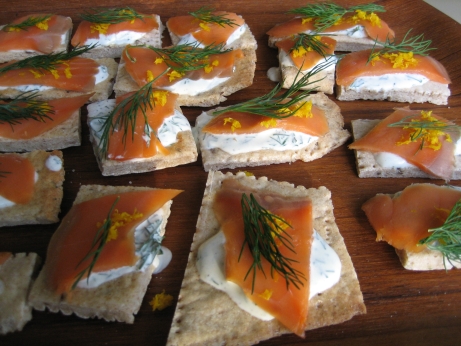
Unfortunately there’s no recipe online.
The Book has a deep and abiding affection for streusel-toppings. I suspect that if the cooks at the Gourmet test kitchen leave their batter alone for too long, they’ll find that Ruth Reichl has snuck in and covered it in streusel. I don’t particularly have anything against streusel toppings, they add a nice textural contrast, but they tend to be very sweet. If the underlying baked good didn’t already have 30% more sugar than it needed, that could be a nice addition, but here it struck me as trying to gild the already candied lily.
The recipe starts by blending brown and white sugar with flour, salt, and butter. The streusel topping is made by separating out some of this mixture and working in cinnamon, additional butter, more brown sugar, and chopped pecans. A mixture of sour cream, egg, egg yolk, vanilla, baking soda, and orange zest is incorporated with the remainder of the flour-sugars-butter mixture, then divided up into 18 muffin cups, topped with the streusel, and baked.
There are a lot of things I liked about this recipe, but as is often the case The Book went overboard on the sugar (1 3/4 cups of sugar to 2 1/2 cups of flour). The cakes were rich, dense, and moist, with a soft slightly elastic texture. The orange zest in the cakes was an excellent touch. The topping was double extra sweet, but I really liked the complexity the pecans and molasses in the brown sugar brought to the cakes. I wish that the recipe had less sugar, and more nuts. Keeping the nuts out of the cake batter highlighted them and broke up the uniformity of the muffin. Unfortunately the streusel topping had a habit of falling off. Next time I’d be more careful about pushing the topping down into the batter.
This recipe is found in the Breakfast and Brunch chapter, but these cakes might work better with afternoon coffee, or as a dessert. They were a bit much for breakfast. I brought these over to a pot-luck brunch, to positive reviews, but they didn’t really do it for me. The next day I had one with an unsweetened espresso, and found I liked them much better. The concept and flavours are solid, and the bitter coffee provided some much needed contrast.
